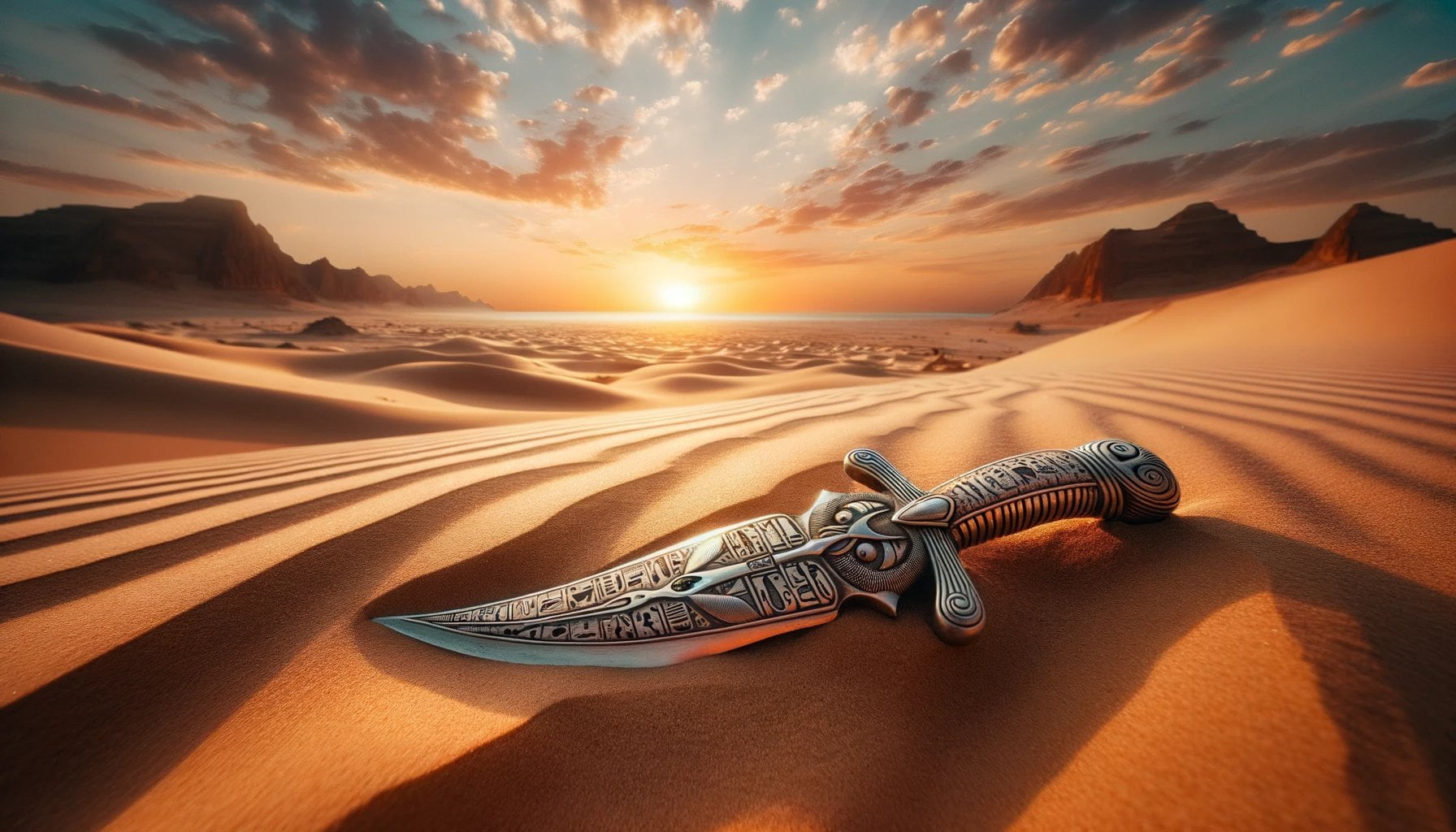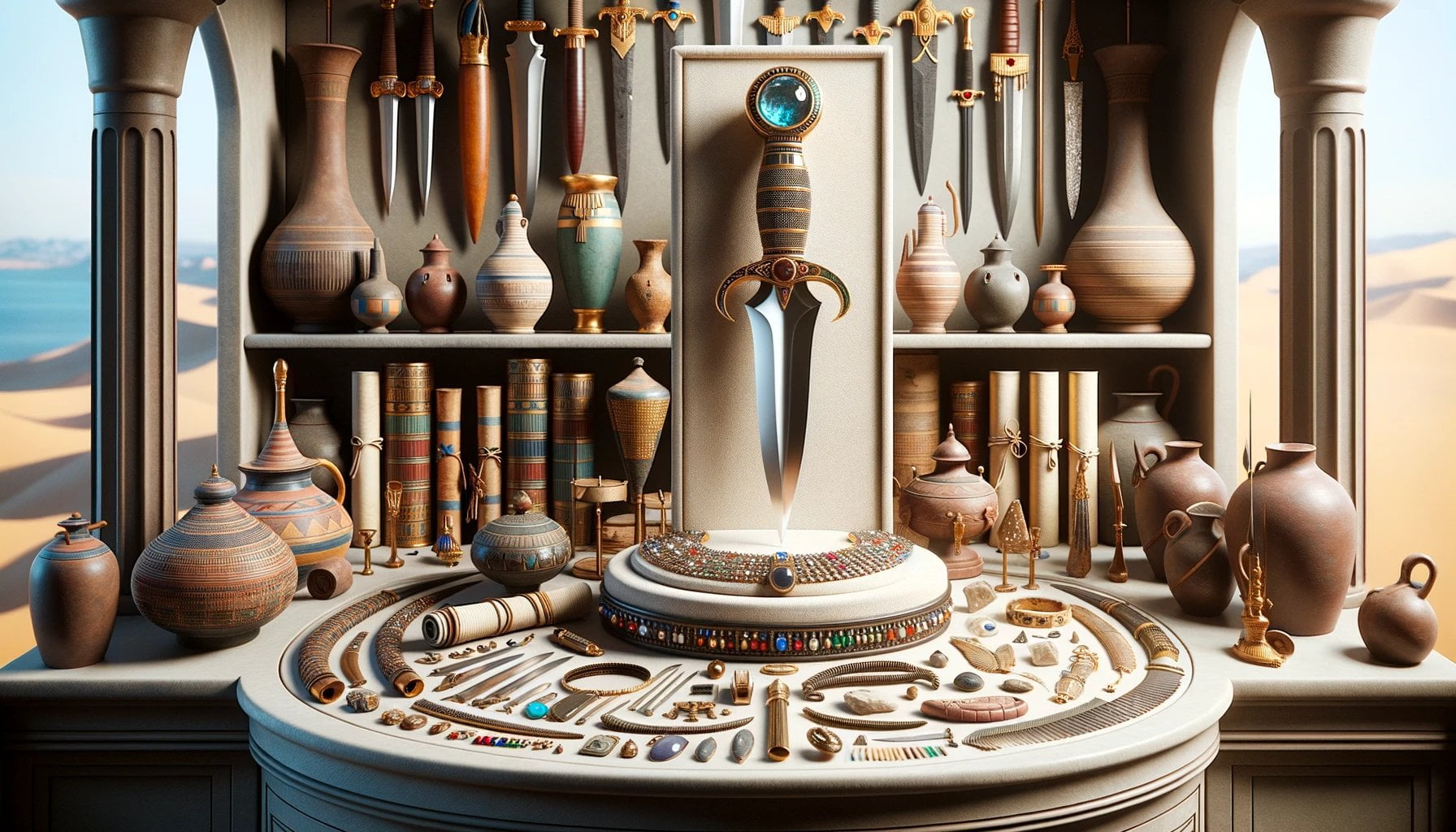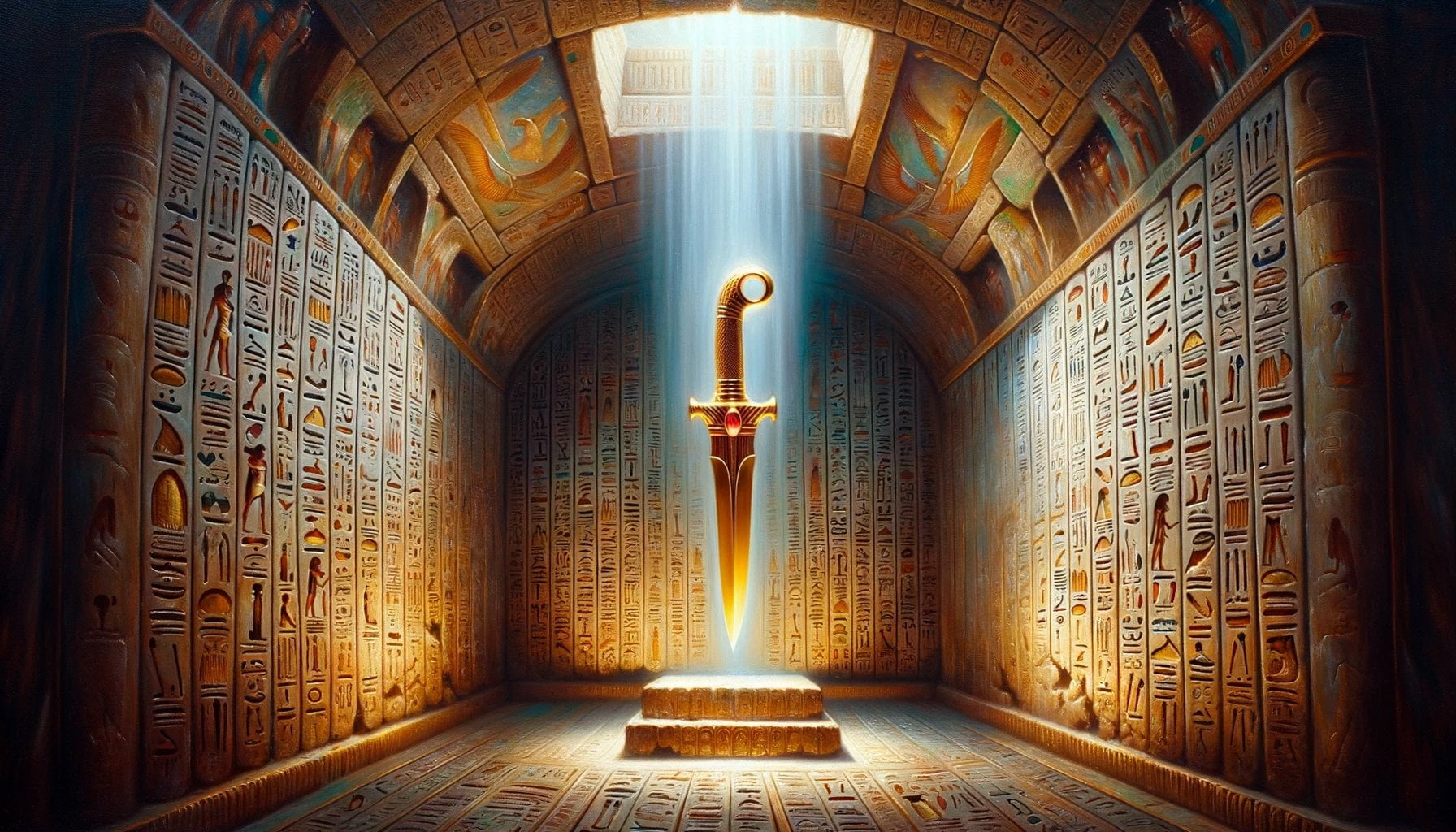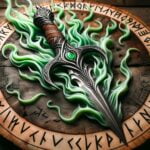Unveiling Egyptian Dagger: Warfare, Craftsmanship, and Cultural Symbolism explores the captivating world of ancient Egyptian weaponry and its significance in their society. Delving into the realm of warfare, craftsmanship, and cultural symbolism, this article sheds light on an intriguing question: Did Egyptians have daggers? As an experienced archaeologist with a specialization in ancient Egyptian history, this exploration draws upon a decade of fieldwork and research, unraveling the mysteries of the past to reveal the role of daggers in Egyptian civilization.

Did Egyptians have daggers?
The presence of daggers in ancient Egyptian society has long been a topic of speculation and curiosity. As an experienced archaeologist specializing in ancient Egyptian history, I have dedicated my career to unraveling the mysteries of this fascinating civilization. Today, we will explore the intriguing question: Did Egyptians have daggers?
To begin our journey into the past, let’s examine a renowned artifact that sheds light on the role of daggers in ancient Egyptian culture. Found in the tomb of the famous Pharaoh Tutankhamun, a dagger made from meteoric iron captured the attention of archaeologists and historians alike. This extraordinary discovery highlighted the Egyptians’ potential use of celestial metal in their weaponry.
This dagger, known as Tutankhamun’s meteoric iron dagger or King Tut’s dagger, has been carefully analyzed using non-destructive techniques such as X-ray analysis. These investigations have revealed that the blade of the dagger indeed originated from a meteorite. Such an exquisite and rare material would have undoubtedly held significant cultural and symbolic value to the ancient Egyptians.
While this dagger provides fascinating insight into the craftsmanship and technological capabilities of the Egyptians, it is essential to place it within the broader context of ancient Egyptian warfare. The presence and significance of daggers as weapons in their military practices can be a topic of speculation.
When exploring ancient Egyptian weaponry, we find a diverse array of tools used in battle. Maces, spears, javelins, battle axes, and short swords were all part of the ancient Egyptians’ arsenal. While these weapons served various purposes on the battlefield, it is worth noting that the use of iron weapons was not widespread in ancient Egypt until much later, around the 6th century BC.
This delay in adopting iron weapons may have had implications for the military successes and defeats experienced by the Egyptians. Other civilizations, such as the Hittites, had already embraced iron weapons, giving them a technological advantage. The Egyptians, still reliant on bronze weaponry, may have found themselves at a disadvantage.
As we delve deeper into the question of whether Egyptians had daggers, it is crucial to consider the lack of archaeological evidence for iron smelting in ancient Egypt until the 6th century BC. This absence suggests that, at least during certain periods, daggers made entirely from iron were not commonly used by the Egyptians.
Nonetheless, the presence of daggers in Egyptian society cannot be entirely dismissed. While they may not have been widespread, their existence is evident through various depictions and references in ancient Egyptian art and literature. These visual and textual sources provide valuable clues about their significance and symbolic roles, indicating that daggers held cultural and religious connotations.
In ancient Egyptian society, wrapping a dagger close to a king’s body was believed to be a divine gift. This association with the gods suggests that daggers held substantial cultural and religious importance, even if they were not extensively used in warfare. The symbolic value of daggers in ancient Egyptian culture cannot be understated.
In conclusion, while the use of daggers as weapons may not have been as prevalent in ancient Egypt compared to other tools of war, their cultural symbolism and significance cannot be overlooked. The meteoric iron dagger found in King Tutankhamun’s tomb provides a captivating example of the Egyptians’ craftsmanship and the potential use of celestial metals in their weaponry. Through careful analysis and comparison, we continue to uncover the fascinating mysteries of ancient Egypt, inching closer to understanding the role of daggers in their society.
So, did Egyptians have daggers? Yes, but their prevalence and use may not have been as extensive as other weapons. Nevertheless, daggers held cultural, religious, and symbolic importance, signifying the interplay between warfare, craftsmanship, and cultural practices in ancient Egypt. Let us continue our exploration of ancient civilizations, unearthing their secrets one artifact at a time.
Ancient daggers have always fascinated historians and collectors alike. If you’re interested in exploring the rich history behind these extraordinary weapons, be sure to check out our collection of ancient daggers here.
Analysis of Egyptian Artifacts and their Depiction of Daggers
In ancient Egypt, the presence and significance of daggers have long intrigued scholars and archaeologists. While iron weapons were not widespread until the 6th century BC, the discovery of King Tutankhamun’s meteoric iron dagger sheds light on the Egyptians’ potential use of celestial metal in weaponry.
The iron blade of Tutankhamun’s dagger, found in his tomb, originated from a meteorite. Advanced techniques, such as X-ray fluorescence analysis, have confirmed its composition, which closely matches that of previously discovered iron meteorites. This finding suggests that the Egyptians highly prized the rare and valuable iron objects, which were used for artistic and ceremonial purposes.
Ancient Egyptian society did not heavily rely on daggers for warfare, unlike other weapons. The lack of archaeological evidence for iron smelting further suggests that daggers made entirely from iron were not commonly used. However, depictions in ancient Egyptian art and references in literature highlight the existence and cultural significance of daggers. These weapons held symbolic value and were often associated with religious and divine connotations.
The significance of daggers in ancient Egyptian culture cannot be understated. Wrapping a dagger close to a king’s body, for example, was viewed as a divine gift. While not as prevalent as other weapons, daggers played a notable role in their society.
To gain a deeper understanding of these artifacts and their depiction of daggers, extensive research and analysis are required. However, testing ancient Egyptian artifacts has been challenging, primarily due to permission restrictions and technological limitations. Fortunately, recent advancements have improved the analysis process, making it easier to explore the materials and craftsmanship used in ancient Egyptian daggers.
For instance, portable X-ray fluorescence spectrometers now allow for non-destructive testing, providing valuable insights into the composition of ancient artifacts. Additionally, scanning electron microscopy and CT scans have been utilized to establish the provenance of meteoritic iron samples.
Through careful analysis, archaeologists can explore the evolving technologies, military practices, and cultural symbolism associated with ancient Egyptian daggers. By uncovering the secrets held within these artifacts, we can gain a deeper understanding of the past and the intricate ways in which daggers shaped ancient civilizations.
In conclusion, the study of Egyptian artifacts and their depiction of daggers offers a fascinating glimpse into the ancient world. Although daggers were not commonly used in warfare, their cultural and symbolic significance cannot be dismissed. Through meticulous analysis using modern technologies, archaeologists continue to unravel the mysteries surrounding ancient Egyptian daggers, shedding light on their role in warfare, craftsmanship, and cultural symbolism.
Unveiling Egyptian Dagger: Warfare, Craftsmanship, and Cultural Symbolism
Understanding the Significance of Ancient Egyptian Daggers
In the realm of ancient Egyptian history, the presence and significance of daggers have been a subject of bewitching curiosity. While iron weapons were not widely used until later periods, the discovery of King Tutankhamun’s meteoric iron dagger has ignited discussions about the potential use of celestial metal in Egyptian weaponry.
The Magnificence of Tutankhamun’s Meteoric Iron Dagger
Tutankhamun’s dagger, discovered in his tomb, boasts an iron blade that originated from a meteorite. Unveiling its secrets required advanced techniques like X-ray fluorescence analysis, confirming its composition aligns closely with that of previously found iron meteorites. This revelation not only highlights the Egyptians’ high regard for precious iron objects but also emphasizes their utilization in artistic and ceremonial contexts.
The Limited Role of Daggers in Ancient Egyptian Warfare
Contrary to popular belief, daggers were not commonly employed in ancient Egyptian warfare. In fact, the scarcity of archaeological evidence for iron smelting suggests that pure iron daggers were not widespread during this time. However, the intriguing depictions in ancient Egyptian art and references in literature introduce us to the cultural significance surrounding daggers.
Cultural Symbolism and Divine Connotations
Daggers held immense cultural symbolism in ancient Egyptian society. They were intricately intertwined with religious and divine connotations, making them highly valuable objects. The act of wrapping a dagger close to a king’s body, for instance, was viewed as a divine gift bestowed upon the ruler.
Exploring Egyptian Artifacts: Challenges and Advancements
Analyzing ancient Egyptian artifacts, including daggers, has presented its fair share of challenges throughout history. Permission restrictions and technological limitations hindered extensive research. However, recent advancements, such as portable X-ray fluorescence spectrometers, have revolutionized the analysis of these artifacts, allowing for non-destructive testing and providing vital insights into their composition.
Delving Deeper: Materials and Craftsmanship of Egyptian Daggers
By employing meticulous analysis methods, archaeologists can unravel the mysteries surrounding Egyptian daggers. Cutting-edge techniques like scanning electron microscopy and CT scans have become invaluable tools in establishing the origin and composition of meteoritic iron samples.
Unveiling the Past: Daggers and Ancient Civilization
Through in-depth analysis and comparison, archaeologists can explore the intricate connection between ancient Egyptian daggers and their evolving technologies, military practices, and cultural symbolism. By uncovering the secrets embedded within these artifacts, we gain profound insights into ancient civilizations and the significant role daggers played in shaping their narratives.
As we continue to investigate Egyptian artifacts and their depiction of daggers, we unravel the mysteries of the past, shedding light on the fascinating worlds of warfare, craftsmanship, and cultural symbolism.
Comparison with Other Ancient Civilizations and Their Use of Daggers
The use of daggers as a weapon and symbol is not unique to ancient Egypt. Many other ancient civilizations also utilized daggers in various capacities. By comparing the use of daggers in ancient Egypt with other ancient civilizations, we can gain a better understanding of their significance and role in warfare, craftsmanship, and cultural symbolism.
Daggers in Ancient Mesopotamia
In ancient Mesopotamia, the use of daggers was not as prevalent as in ancient Egypt. Swords and blades were considered rare and expensive in both societies. It wasn’t until the Middle Eastern soldiers encountered swordsmen from other regions around 1000 BCE that the use of swords became more widespread. This suggests that daggers may have been used as spare weapons when the main weapon was difficult to use, similar to the practices seen in ancient Egypt.
Daggers in Other Ancient Civilizations
Looking beyond Mesopotamia, other ancient civilizations such as the Greeks, Romans, and Persians also valued the use of daggers. These civilizations had a rich military history and incorporated daggers into their weaponry alongside other weapons like spears, swords, and bows. Daggers served as versatile weapons that provided close-quarters combat capabilities.
Craftsmanship and Cultural Symbolism
While the use of daggers in warfare was not as prominent in ancient Egypt as in other civilizations, their craftsmanship and cultural symbolism cannot be undermined. Archaeological findings, such as the ornamental golden dagger gifted to Egyptian Queen Ahhotep I, highlight the cultural significance of daggers in ancient Egyptian society. It is also important to note that prehistoric daggers, previously thought to be ceremonial, were discovered to have been used in combat and animal slaughter.
Conclusion
Through a comparison with other ancient civilizations, we can recognize that daggers held varying degrees of importance in different societies. While not as widely used in warfare as in other civilizations, daggers played a significant role in ancient Egyptian society, both as weapons and symbols. By unraveling their significance through comprehensive analysis, we can gain insight into the evolving technologies, military practices, and cultural symbolism associated with Egyptian daggers.
Conclusion: The Presence and Importance of Daggers in Ancient Egyptian Society
Throughout ancient Egyptian history, the presence and significance of daggers cannot be underestimated. Despite the ongoing debate surrounding the extent of their use in warfare, it is evident that daggers held cultural, religious, and symbolic connotations in Egyptian society. The discovery of Tutankhamun’s meteoric iron dagger in his tomb shed light on the potential use of celestial metal in Egyptian weaponry, highlighting the exceptional craftsmanship and technological advancements of the time.
The iron-bladed dagger found in Tutankhamun’s tomb is believed to have originated from a meteoritic landing, as confirmed by X-ray analysis. Its unique composition and homogeneity suggest that ancient Egyptians had access to celestial metal and possessed knowledge of its exceptional properties. This discovery not only demonstrates their advanced metallurgical skills but also reinforces the significance of daggers as divine gifts from the gods, as the Egyptians believed the meteorite to be a heavenly offering.
Daggers, although not as prevalent as other weapons in ancient Egyptian warfare, served both defensive and offensive purposes. With their sharp points and compact design, they provided versatility and effectiveness in combat. Their symbolic value was undeniable, representing royalty and power in a society with a strict hierarchical structure. Wrapping a dagger close to a king’s body was seen as a divine gift, further emphasizing their importance.
While archaeological evidence for the widespread use of daggers made entirely from iron is lacking, depictions in ancient Egyptian art and references in literature undeniably point to the existence and cultural significance of these weapons. Daggers were crafted ornately, reflecting the fine craftsmanship and artistic prowess of ancient Egyptian culture. They were not only used in warfare but also served in ceremonial and religious contexts, highlighting their multifaceted role in society.
The preservation of Tutankhamun’s iron dagger, which remarkably showed no signs of rust despite its age, attests to the advanced technological knowledge and craftsmanship of ancient Egyptians. Their ability to create weapons capable of withstanding the corrosive effects of time showcases their mastery in metallurgy and weaponry production.
In conclusion, the presence and importance of daggers in ancient Egyptian society cannot be understated. While they may not have been as widespread in warfare as in later centuries, they held significant cultural and symbolic value. Tutankhamun’s meteoric iron dagger serves as a testament to the advanced metallurgical skills possessed by the ancient Egyptians, as well as their belief in the divine origins of these weapons. By studying Egyptian artifacts, including daggers, archaeologists gain valuable insights into evolving technologies, military practices, and cultural symbolism prevalent in ancient civilizations.
Table: The Significance of Daggers in Ancient Egyptian Society
| Aspect | Significance |
|---|---|
| Symbolic Representation | Daggers represented royalty and power in Egyptian society, emphasizing the hierarchical structure. |
| Warfare Usage | While not as prevalent as other weapons, daggers served both defensive and offensive purposes. |
| Divine Gift | Wrapping a dagger close to a king’s body was seen as a divine gift, bestowed by the gods. |
| Technological Advancements | The preservation of Tutankhamun’s iron dagger showcased advanced metallurgical skills. |
| Cultural and Religious Use | Daggers played a role in ceremonial and religious practices, emphasizing their cultural significance. |
Overall, the presence and importance of daggers in ancient Egyptian society were multifaceted, encompassing warfare, craftsmanship, and cultural symbolism. By analyzing these artifacts, archaeologists can gain a deeper understanding of evolving technologies, military practices, and the societal significance of daggers. The study of ancient Egyptian history and material culture continues to unravel the mysteries of the past and shed light on the rich and complex society of this ancient civilization.

FAQ
Q1: Were daggers common in ancient Egyptian society?
A1: While daggers were not as prevalent as other weapons in ancient Egyptian society, they did have a significant presence. They were used for both practical and symbolic purposes, representing royalty and power.
Q2: How was the composition of Tutankhamun’s dagger determined?
A2: The composition of Tutankhamun’s dagger was analyzed using X-ray fluorescence analysis. It was found to be mostly made of iron, with 11% nickel and 0.6% cobalt. This high nickel content suggests that the iron originated from a meteorite.
Q3: What was the significance of daggers in ancient Egyptian warfare?
A3: Daggers served as important fighting weapons in ancient Egyptian warfare. With their sharp points, they were used for both defensive and offensive purposes. They were often employed as spare weapons in situations where the primary weapon was impractical to use.
Q4: Did ancient Egyptians have access to iron for weapon-making?
A4: The use of iron for weapon-making was limited in ancient Egypt, particularly during Tutankhamun’s time. Iron smelting and manufacture were rare, making iron objects highly valuable and primarily used for artistic and ceremonial purposes.
Q5: How did ancient Egyptians perceive daggers?
A5: Ancient Egyptians considered daggers to be gifts from the gods. They wrapped them close to their king’s body, symbolizing their significance and association with royalty and power.
- SYBAU See You Baby Meaning: Gen Z Slang Evolves - July 1, 2025
- Unlock Your Inner Youth: Lifestyle Secrets for a Vibrant Life - July 1, 2025
- Decode SYBAU Meaning: Gen Z Slang Explained - July 1, 2025






